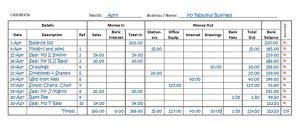
It gives an idea about the dividends that the shareholders will receive. With a uniform listing criterion established by an accounting GAAP, it becomes easier for retained earnings balance sheet various stakeholders to understand, analyze the company’s balance sheet and make decisions accordingly. This increases both intra-company and inter-company balance sheet comparability.

Order of Items on the Balance Sheet
- It gives an idea about the dividends that the shareholders will receive.
- Under IFRS, an entity is not required to have separate classifications as long as a liquidity-based presentation provides reliable and more relevant information than a classified balance sheet does.
- Shareholders’ equity is closely monitored by investors and analysts as it reflects the company’s ability to generate profits and sustain growth over time.
- Equity is a measure of a company’s financial health, indicating the net value of the business that belongs to its shareholders.
- For many companies, accounts receivable is more liquid than inventories (meaning the company expects to receive payment from customers faster than it takes to sell products in inventory).
- This increases both intra-company and inter-company balance sheet comparability.
Even if the asset’s market value increases later, you can’t reverse that write-down. IFRS is more accommodating—it allows the reversal of an asset’s value when its price increases. So under IFRS, you can reflect positive market changes, making your balance sheet more current. Adhering to the standard order of assets from most to least liquid provides consistency and clarity on financial statements. This enables efficient analysis and comparisons for internal and external stakeholders. Intangible assets help generate economic benefits but lack quick liquidity apart from selling the entire company.

Supercharge your skills with Premium Templates

Whether you are starting your first company or order of liquidity you are a dedicated entrepreneur diving into a new venture, Bizfluent is here to equip you with the tactics, tools and information to establish and run your ventures. At Financopedia, we’re committed to assisting small businesses and individuals with their finances and taxes. However, this order may vary depending on the specific needs of the company.
A guide to liquidity in accounting
Let’s say an asset’s value takes a hit—maybe your state-of-the-art equipment becomes obsolete overnight (curse you, technology!). Under GAAP, once you write down an asset due to impairment, there’s no turning back. It means that the company has rendered services or delivered the product to the customer. Difficult to convert directly to cash and has an indefinite useful life. Few other names of a balance sheet are Statement of Financial Position, Statement of Financial Condition or Statement of Net Worth. Take your learning and productivity to the next level with our Premium Templates.
- Even the value of a firm, the financial health of a firm is determined by a company’s current assets.
- Think of it as your company’s financial selfie, capturing everything at a specific moment in time.
- «We now expect the FOMC to announce an end to QT next week,» Deutsche Bank strategists said, given money market developments and Fed officials’ desire to make this chapter of balance sheet management smooth.
- The terms “cash” and “liquidity” are often used interchangeably even in some business meetings, investor calls, and financial communications.
- Naturally, cash is the most liquid asset, whereas real estate and land are the least liquid asset, as they can take weeks, months, or even years to sell.
- Under IFRS, deferred taxes are classified as non-current liabilities, and footnotes are required to explain the details.
Changes in equity can occur through various events, such as share issuances or repurchases, dividend payments, net income or losses, and changes in the fair value of Bookkeeping for Startups certain assets. These fluctuations impact the overall equity position of the company and can provide insights into its financial performance and capital structure. Under IFRS, deferred taxes are classified as non-current liabilities, and footnotes are required to explain the details. GAAP allows deferred taxes to be listed as both current and non-current liabilities and doesn’t have this footnote requirement. So GAAP offers more flexibility in classification but less transparency.



Comentarios